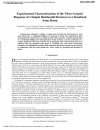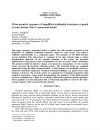Experimental Characterization of the Vibro- Acoustic Response of a Simple Residential Structure to a Simulated Sonic Boom
Experiments performed to validate a model used to predict the transmission of weak sonic booms into a residential building are discussed in detail. The experimental effort encompassed the construction of a simple structure that retains the essential characteristics of a residential building, the instrumentation of this structure, and the production of a realistic simulated sonic boom with the use of detonating cord. Vibro-acoustic data were collected using the simulated sonic boom as excitation.






